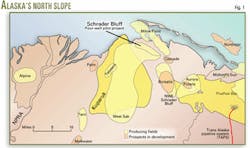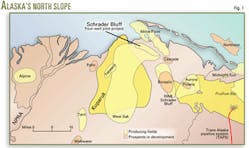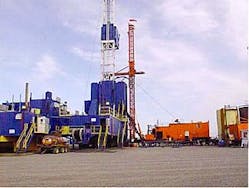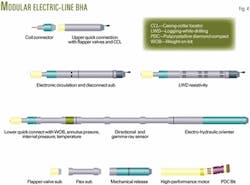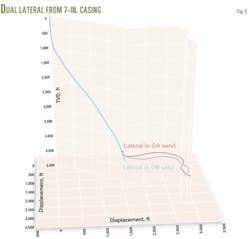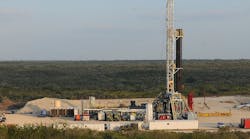Based on a presentation to the International Association of Drilling Contractors and Society of Petroleum Engineers drilling conference, Dallas, Feb. 26-28, 2002.
A multidiscipline team, assembled by BP Exploration (Alaska) Inc., completed a successful four well, coil-tubing drilling (CTD) pilot project to drill long horizontal multilateral sidetracks into the Milne Point Schrader Bluff field's shallow, heavy-oil reserves on Alaska's North Slope.
With drilling rates routinely in excess of 250 fph, the project demonstrated that coiled tubing could quickly drill through-tubing laterals longer than 2,500 ft into the sandstone reservoirs, delivering good incremental oil production rates at low cost.
The field was new for the CTD team, with challenging directional and completion issues, requiring a coiled tubing, electric-line bottomhole assembly (BHA) for drilling and executing innovative completion techniques.
CTD with the electric-line umbilical roughly doubled historical rate-of-penetration performance compared to CTD mud-pulse telemetry, and provided excellent steering capability within the relatively thin, soft sandstone layers at Schrader Bluff.
The team drilled three dual-lateral wells and one single-lateral into thin shallow sands, completing the seven laterals with slotted liners and flow-through whipstocks.
Sensors in the modular electric-line BHA communicated extremely high-speed directional information, real-time downhole weight-on-bit (DWOB), resistivity data, gamma-ray data, internal pressure, and annular-pressure data to surface.
The 5 sec bottomhole data updates from the measurement-while-drilling (MWD) tools, through the electric-line umbilical, allowed precise well steering.
In addition, the electric line provided power to accurately drive a downhole electric orienter. High data-rate WOB and pressure-while-drilling information also improved drilling performance.
These features combined with high performance, positive-displacement motors achieved very high penetration rates with 3 3/4-in. polycrystalline diamond compact bits, setting several North Slope CTD records during the project.
The electronic BHA also facilitated accurate placement of five whipstocks during the project. Precise toolface control and DWOB enahanced the window milling operations.
Running predrilled liners into the laterals from high departure parent wellbores proved challenging but ultimately successful, with the liner weight being the main controlling factor affecting drag and resulting helical buckling.
Reducing liner size and weight, adding drill collars between the coil tubing and liner, and reducing friction improved the team's ability to overcome liner drag.
Shallow oil
Milne Point field covers 32,000 acres on Alaska's North Slope coast and lies between Prudhoe Bay and the Kuparuk River oil fields (Fig. 1).
Laid down in the Upper Cretaceous, the Schrader Bluff reservoir contains viscous oil at a subsea depth of 4,000 ft TVD and consists of two sand and siltstone pay zones labeled OA and OB, each about 25 ft thick (Fig. 2). The Schrader sands lie above the separate Kuparuk River (7,000 ft TVD subsea) and Sag River (8,800 ft TVD subsea) reservoirs, which contain lighter oils.
Nonproductive siltstone, immediately above and below the Schrader sands, also separates the highly faulted pay zones with a 35-ft siltstone layer.
Hard siderite stringers lie randomly throughout the Schrader reservoir. Permeability ranges from 200 to 300 md for the Schrader OA and OB sands, and the reservoir temperature is 80° F.
Cost-effective development of Alaska's North Slope shallow oil reserves has historically proven difficult and was only possible on the strength of giant Prudhoe Bay field.
The shallow sands on the North Slope may contain up to 15 billion bbl of viscous oil in place but production rates from past conventional well designs have been economically marginal, because of the high viscosity 16.5° API oil.
Development history
Prior to acquisition by BP, the operator produced this North Slope shallow viscous oil reservoir through simple directional monobores and electrical-submersible pump completions. Because of low production rates and poor economics, the company changed to fractured wells and prepacked screen completions.1
Long horizontal laterals, drilled and completed to more than 1,000 ft, had shown success in 1998, and in 2000 the first long horizontal multilaterals, drilled by rotary rigs, showed continuous productivity improvement.
Even though CTD has seen extensive use in other areas of Alaska's North Slope, it was not until this project that CTD had drilled long, through-tubing horizontal multilaterals from existing Schrader Bluff wells.
This CTD sidetrack pilot project built on the huge success of the rotary drilling multilateral program.
Since 1994, coiled tubing has drilled through-tubing sidetracks extensively in Prudhoe Bay field, and in 2001 CTD had realized about 2.6 rig years of activity sidetracking over 80 wells, mostly through 4 1/2-in. tubing with 3 3/4-in. fixed cutter bits.
Several authors have written on common techniques used.1-4
Well designs, results
The four CTD through tubing, medium-radius multilateral sidetracks targeted the OA and OB sands of the Schrader Bluff reservoir (Fig. 2). The project called for drilling the different multilateral designs through 4 1/2-in. tubing out of 4 1/2, 5 1/2, and 7-in. casing sizes.
Fig. 3 shows the coiled-tubing drilling rig that can accommodate a reel of coil with electric line for drilling as well as coil without electric line for running completions or cementing.
The team planned to drill 2,500-3,500 ft horizontally, although drag modeling suggested that the lengths were optimistic with drag and coiled-tubing helical buckling causing problems for running liners.
Following are the well design and completion highlights, in the order drilled:
CTD drilled the two laterals, 2,245 ft and 2,448 ft, in total lateral length and completed them with 2 7/8-in. predrilled liners. Unexpected zone displacement from faulting required sidetracking to complete the first lateral, extending drilling time, but the second lateral was drilled in 63 hr, including wiper trips.
The first lateral built angle with 58°/100 ft dogleg severity turning 180° azimuth. In 41 hr of drilling, CTD had completed the lateral to 1,656 ft total length.
With less aggressive build section for the second lateral, CTD operations drilled 3,406 ft, which included an openhole sidetrack for unexpected throw on a geologic fault, for a total lateral length of 2,631 ft in just over 5 days.
Drilling the total lateral lengths to 2,352 ft and 2,702 ft, respectively, CTD operations set a record for footage drilled in one day.
Modular electric-line BHA
The Schrader Bluff project used a modular coiled-tubing drilling and evaluation BHA (Fig. 4). The bidirectional electric-line umbilical powers the measurement sensors and allows high-speed communication of downhole data and high-speed control of the BHA tool face.
The downhole motor is a new design 27/8-in. OD high torque, positive-displacement motor (PDM) with adjustable kickoff sub for directional control.
The high performance motor provides twice the torque and power output of the conventional PDMs, which can stall when drilling into something hard with too much weight on bit, requiring the driller to pick up off bottom to get the motor turning again.
The high performance PDMs significantly reduce stalling and the need for pulling the bit off bottom. It will drill off even when motor loads are double the loads placed on conventional motors.
Above the motor are the electronically controlled hydraulic orienter and the downhole measurement sondes, with directional sensor, gamma-ray sensor, and sensors for DWOB, annular pressure, and internal pressure.
The electronically controlled hydraulic orienter allows the directional driller to control the orienter with a computer mouse. It rotates within a range of 400°, at 1°/sec, and allows for orientation while on bottom so that little or no time is lost for orienting.
High rate, real-time downhole data capture at 5 sec intervals has proven valuable for knowing and understanding downhole conditions. With CTD it is often difficult to know what is going on downhole because of buckling and stretch in the coil.
Above the measurement sondes is the modular resistivity sub that employs two transmitters, two receivers, and two frequencies (2 Mhz and 400 khz), to make four fully compensated resistivity measurements for thin beds and deep investigation.
The tool successfully maintained accuracy with the solids-free mud system when chlorides often were more than 30,000 ppm.
The electrically controlled circulation and disconnect sub, above the resistivity sonde, contains a bypass valve and release tool.
The driller opens the circulation valve for circulation on trips, pumping pills, hydraulically setting whipstocks, and to increase flow rates in the casing after wiper trips through the open hole.
The driller also used the circulation valve to avoid turning the bit inside the casing while pumping to prevent fluid freezing and to avoid pumping meth- anol, used for coil freeze protection, through the rubber components of the BHA.
The upper quick connect, which contains a dual-flapper valve and electric-line anchoring assembly contained in a housing with nonrotating threads, allows connection to coiled tubing without rotating the entire BHA.
Flexible subs between the motor and orienter and flexible lower quick connects allow passage through dogleg severities of more than 45°/100 ft.
The BHA attaches to the 2 3/8-in. OD, 1.995-in. ID, 90,000-psi tensile strength coiled tubing with a standard coil-tubing connector. The system has enough flow area to allow fluids to pass, with the electric-line umbilical in place.
Drilling operations
Fig. 5 shows the wellbore and lateral trajectories for the fourth well in the pilot project, as an example of the lateral drilling and recompletion operations. The dual laterals, drilled from the existing 7-in. casing and through 41/2-in. production tubing targeted the OA and OB sands.
Crews plugged existing perforations in the OA and OB sands of the parent wellbore by cementing and isolating with a cement retainer set at 4,548 ft MD.
The driller then set the first 41/2-in. by 7-in. through-tubing whipstock in the wellbore at 4,536 ft MD and 51° inclination, using high-speed gamma ray and CCL for precise positioning.
The BHA contained the whipstock, setting sleeve, setting tool, mechanical release tool, flapper valve sub, orienter, lower quick connect, electric circulation and disconnect sub, upper quick connect with CCL, and the coiled-tubing connector.
Lower lateral
For the lateral targeting the lower OB sand, a diamond speed mill, string reamer, straight standard PDM, flapper valve sub, and remainder of the BHA above drilled the lower lateral casing exit through the 7-in., 26 lb, L-80 casing in one run.
Crews ran a standard short-radius motor with 2.5° bend and drilled the 40°/100 ft build section, landing the well at 4,690 ft MD.
The lateral drilling BHA used the high-performance motor set at 1.2° bend. After drilling less than 1,000 ft (to 5,627 ft), engineers discovered that formation dip was less than expected and the wellbore was going out the top of the zone.
The driller performed a low side openhole sidetrack at 4,860 ft MD with a 1.5° bend motor and 18 hr after the sidetrack decision was made, the well was back to 5,627 ft MD and drilling in zone.
Engineers allowed drilling rates to go to 230 fph, and extended wiper trips because close monitoring of equivalent-circulating density showed no cuttings buildup.
No unusual changes between surface and DWOB and no problems with weight transfer or differential sticking occurred. Wiper trips were clean.
One of the drilling days set a new single day Alaska North Slope lateral footage record at the time, with 1,722 ft drilled from midnight to midnight.
As lateral drilling continued, operations became increasingly difficult, with DWOB showing poor weight transfer. Crews swapped the mud system to get solids down below 1% and ultimately drilled the lateral to the targeted TD of 6,888 ft MD.
With the electric-line coiled tubing, crews ran the 2 3/8-in. predrilled liner through the lateral section in less than 1 hr and with good weight transfer.
To reduce friction, engineers ran the predrilled liner with turbolators or centralizer-like devices and laid new mud with 6% lubricants in the open hole prior to running.
Twelve joints of 3 1/8-in. drill collars and one 2 3/8-in. drill collar, run above the liner but below the coiled-tubing BHA added the necessary weight to push the liner into the open hole.
Upper lateral
The driller oriented and hydraulically set the second 4 1/2-in. by 7-in. flow through, through-tubing mechanical whipstock above the first lateral whipstock at 4,505 ft MD and 25° inclination and milled the window through the 7-in. casing.
The whipstock contained a radioactive tag to allow easy gamma-ray tie-ins later.
With a 2.5° bend standard motor, the driller landed the 40°/100 ft build section in the OA sand at 4,841 ft MD, tripped for a 1.2° high-performance motor, and drilled the 2,366 ft MD lateral section in just 38 hr, with much of the lateral drilled at 200 fph with 2.3 bbl/min flow rates.
Poor weight transfer occurred and the BHA became sticky on bottom when the driller increased ROP to 260 fph at 2 bbl/min flow rate. Maintaining flow rates at 2.2 bbl/min, the driller limited ROP to 230 fph.
After a short trip at 6,480 ft MD the driller allowed the ROP to increase to 335 fph, with flow rates of 2.3 bbl/min. No hole problems occurred, although getting the weight to bit required snubbing at surface.
With the lateral drilled to 7,207 ft MD, weight transfer became a problem but the unit had achieved the target TD.
Crews ran the 2 3/8-in. predrilled liner, with the same BHA components as on the previous lateral, and released it hydraulically at the desired depth.
The 1-in. inner-string wash pipe flushed bleach across the slotted liner and allowed displacement with brine.
Performance
The four well pilot project has proven coiled-tubing's ability to economically drill long through-tubing laterals, while staying in zone, in the Schrader Bluff's shallow 25-ft thick OA and OB sands.
Seismic resolution was often insufficient to accurately predict the magnitude of fault throws, requiring four openhole sidetracks to stay within the zone for the seven laterals drilled. The openhole sidetracks, however, proved to be easy in the soft sands and were relatively inexpensive to perform.
The immediate downhole data capture from the electric-line telemetry allowed the drilling team to mitigate the risks of drilling out of zone due to unexpected formation dip, BHA deflections caused by hitting hard siderite stringers within the reservoir, or deflections off of siltstones above and below the reservoir sands.
The directional drillers could build a much more complete mental model of directional performance from the continuous stream of well-path survey data, rather than the standard mud pulse system 30-ft survey sections.
DWOB and internal pressure gave accurate account of bit and motor loads so that the directional driller could more precisely predict turn rates through nonhomogenous formations.
The electro-hydraulic downhole orienter turned at 1°/sec allowing the driller to make toolface changes on the fly while drilling. Making tool face changes over a distance without abruptly changing direction creates a smoother well path with less drag.
This orienting system also significantly reduced orienting time over hydraulic orienters, which typically require cycling of the pumps to get 20° increments for a right-hand rotation.
Avoiding flow cycling removes downhole pressure fluctuations-less flex or stress occurs to the wellbore walls-increasing wellbore stability. Continuous circulation yields better hole cleaning because cuttings do not collect on the low side of the hole when circulation stops.
The driller opened and closed the bypass circulation sub within the electrical disconnect at will, allowing circulation while tripping in and out of the hole without the risk of damaging the bit or the casing, resulting in less wear and tear on the downhole motor.
The device allowed 20% flow rate increase when opened to clean the wellbore of metal shavings or drilled cuttings.
The electric coil and BHA system performed whipstock running and window milling efficiently and without incident on all four wells.
The guesswork in the operations was reduced because of the system's ability to orient continuously bidirectionally, observe realtime precise DWOB, bypass circulate, measure internal and annular pressure, and see casing collars and gamma ray continuously.
Because of high formation evaluation data capture rate, drilling of the laterals generated complete real-time logs, at all drilling rates and without missing data.
The system acquired all of the gamma ray and four compensated resistivity readings while drilling at ROPs up to 300 fph. Mud pulse systems could not have accomplished this, being limited to 200 fph ROP to acquire a resistivity log that provides just enough information to be valuable.
Good communication had to be established, between the directional drillers and rigsite geologist, to stay in zone with the very high drilling speeds realized on the project.
Hole cleaning problems have historically limited drilling rates for CTD on Alaska's North Slope to 200 fph, with wiper trips every 100 ft to assure hole stability and to wipe cuttings up the hole.
The wealth of downhole WOB and downhole pressure data made it simple to monitor cuttings build up. After a wiper trip or two, if annular pressures do not increase and shale stabilities remain good then drillers can reduce wiper trips on future wells to improve overall drilling rates.
The seven laterals drilled were complex and exceeded the difficulty of most North Slope CTD wells.
Most wells drilled prior to this pilot project did not require dogleg severity up to 45°, were not dual lateral, did not require precisely set multiple whipstocks, did not require liner tops set precisely on depth, and did not extend in excess of 2,500 ft MD for each lateral.
The risk of an expensive downhole mechanical incident on at least one of the seven laterals was high but none occurred. The average daily footage drilled continually improved for each lateral.
Each well produced about 1,000 bo/d initial production rate. This four-well pilot project provided an initial 8% oil production increase for the field, was completed 10% under budget, and achieved perfect health, safety, and environmental performance.
Acknowledgments
The authors thank Colin Mason, with BP-Sunbury Research, for drag modeling research; the entire rig team for outstanding performance; and Mark Dalton, Clement Dapp, Haske van Gurp, and Dave Tolf of Baker Hughes INTEQ for their rigsite contributions to the Milne Point CTD project. The authors also thank BP Exploration (Alaska) and Baker Hughes INTEQ for permission to publish the article.
References
- Williams, B., "Operators unlocking North Slope's viscous oil commerciality," OGJ, Aug. 6, 2001, p. 36.
- Goodrich, G.T., Smith, B.E., Larson, E.B., "Coiled Tubing Drilling Practices at Prudhoe Bay," Paper No. SPE 35128, IADC-SPE Drilling Conference, New Orleans, Mar. 12-15, 1996.
- Hearne, D.D., Blount, C.G., Kamlowsky, P.E., "Coiled Tubing Window Milling," Paper No. SPE 35126, IADC-SPE Drilling Conference, New Orleans, Mar. 12-15, 1996.
- Van Venrooy, J., van Beelen, N., Hoekstra, T., Fleck, A., Bell, G., Weihe, A., "Underbalanced Drilling With Coiled Tubing in Oman," Paper No. SPE 57571, IADC-SPE Drilling Technical Conference, Nov. 8-10, 1999.
The authors
Mel Rixse is a drilling systems operations coordinator with Baker Hughes INTEQ, Alaska, responsible for coil-tubing directional drilling. He has also worked as rotary directional drilling operations coordinator for INTEQ, Alaska, and has been involved with directional drilling, MWD, and LWD since 1982. He holds a BS in mechanical engineering from Colorado State University, Fort Collins. He is a member of SPE.
Mark O. Johnson is a staff coiled-tubing drilling engineer for BP Exploration (Alaska) Inc. He is responsible for new venture and mature coiled-tubing drilling projects on the North Slope. Johnson's prior experience includes rotary drilling, remedial well work, and operations engineering. He holds a BS chemical engineering from the University of Southern California, Los Angeles.
